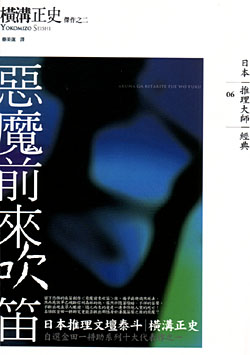 In my journey towards discovering more Japanese detective fiction, I came across the fiction of Yokomizo Seishi 橫溝正史. Noted for creating the extremely popular character Kindaichi Kosuke 金田一耕助, Yokomizo remains one of the most widely read authors in the genre today. Yokomizo plays an important role in the development and popularization of detective fiction in Japan. He became a professional writer before the start of World War II but fame came after the war ended. Publishing his works in serialized format in weekly magazines, Yokomizo quickly established a large following. A large number of his novels have been adapted into films including the famous Village of Eight Tombs 八墓村.
In my journey towards discovering more Japanese detective fiction, I came across the fiction of Yokomizo Seishi 橫溝正史. Noted for creating the extremely popular character Kindaichi Kosuke 金田一耕助, Yokomizo remains one of the most widely read authors in the genre today. Yokomizo plays an important role in the development and popularization of detective fiction in Japan. He became a professional writer before the start of World War II but fame came after the war ended. Publishing his works in serialized format in weekly magazines, Yokomizo quickly established a large following. A large number of his novels have been adapted into films including the famous Village of Eight Tombs 八墓村.
Japanese detective fiction can be sub-divided into many sub-genres, and Yokomizo is considered by critics and readers to be one of the masters of the “orthodox” or “classic” school 本格派. The detective fiction of writers from the “orthodox” school largely resembles the works of Agatha Christie and Arthur Conan Doyle – murders take place, detectives strive to unravel alibis or motives of key suspects and the novel ends with a scene in which all the mysteries are explained. This narrative format continues to be popular today in Japan as can be seen in the popularity of the Detective Conan manga and cartoon series.
For my first Yokomizo novel, I chose the decently lengthy 惡魔前來吹笛 [literal translation would be something like “When the Devil Comes, He Plays the Flute”]. Originally published in 1951, I found the novel a very entertaining book and it did not feel dated. The story starts off with the death of a wealthy aristocrat, but as the investigation progresses, Kindaichi discovers the hideous truth behind relationships within the victim’s family. Some authors of Japanese detective fiction opt for preposterous plot mechanisms (I finished reading one last week*, and the ending REALLY pissed me off), but Yokomizo’s novel remains grounded in plausible plot elements. A fast read despite its close to 500 page length, the novel starts off interestingly, takes a detour and ends on a high note in the typical Agatha Christie a gather-in-the-living-room-for-the-truth moment. Overall, a recommended read.
* Natsuhiko Kyogoku’s 京極夏彥 Ubume No Natsu 姑獲鳥之夏. Considered to be “new orthodox school” 新本格派 author, his mysteries tend to feature seemingly supernatural occurrences, which he then debunks. Although the myths, yokai 妖怪 and folklore he writes about is fascinating, I found the novel slow and bogged down by pseudo philosophizing about religion and perception. The ending was horrendous – apparently the narrator suppressed what he saw and all along the reader (i.e. ME) had been presented simply with a unreliable account of what happened. And I hate it when the murderer turns out to be committed by a person with 3 split personalities, thus making it easy to explain away the motives of killing.